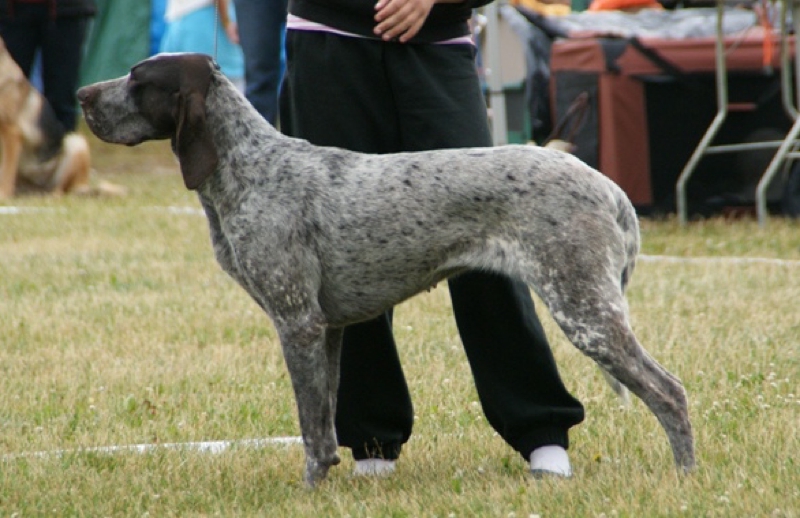Burgos Pointer

Burgos Pointer dogs have existed quietly within central Spain for over 500 years, where local huntsmen have used them to hunt a variety of game. While they are practically unknown anywhere outside of their homeland, this may well change in the future, thanks to their handsome good looks, mellow nature and wide-ranging hunting abilities.
A large dog with a strong body, the Burgos Pointer is elegantly built and has a noble expression with soulful eyes. While they live to hunt, they make good house pets, as they are a pleasure to train and are happy to relax indoors when in the company of people. These dogs should only be housed in environments where they can have the ability to spend time freely outdoors. Due to their high prey drive they would not make a good addition to the family if there are small animals within the home already.
About & History
The Burgos pointer is a large and robust Spanish dog that may also be called the Spanish Pointer or the Perdiguero de Burgos. This dog hails from the centre of Spain and is thought to date back as far as the 16th century. While records are lacking, it is widely accepted that the Pachón Navarro (a pointer) and the Sabueso Español (a scenting dog) were the breed’s main predecessors. The Burgos Pointer itself is thought to have contributed to the genetics of a number of European pointing dogs over the years.
A hunting dog, the Burgos Pointer is suited to a rural lifestyle where it can roam freely. Historically, the Burgos Pointer would have been bulkier and larger but over the years it has evolved into a slimmer dog that is quicker on its feet and is more adept at tracking smaller game. This breed has traditionally been used to hunt deer, but nowadays is used on a variety of animals, including birds, rabbits and foxes. This breed doesn’t mind getting its toes wet and will happily pursue its prey wherever it goes, whether on land or in water. As well as pointing, they are more than able to hunt and retrieve, making them a sought after and versatile hunting companion.
In 1996, the UKC accepted the Burgos Pointer into its Gun Dog group and they are also recognised by the FCI within their Continental Pointing Dog section. While they have come perilously close to extinction in the past, they have experienced a quiet revival in recent years and are valued within Spain today, where they continue to be used for their original purpose.
Appearance

The Burgos Pointer is solidly built with a robust body and sturdy, strong limbs. They have a steady and purposeful gait and a noble demeanour. Their broad muzzle is slightly shorter than their wide skull and they have a modest stop. Their nose must be large and is dark brown in colour. Their eyes should be a dark hazel colour and are almond in shape. Their characteristic ears are long and pendulous, hanging beside their face in a ‘corkscrew’ manner. Their prominent neck has two obvious dewlaps of skin that start from high up and are sometimes called their ‘double chin’. Their body is square in shape and consists of a broad chest, rounded ribs, level back and slanting croup. They have a slight abdominal tuck-up. Their powerful tail is heavy at the root and is often docked.
The short, thick coat of the Burgos Pointer should be smooth and is white and liver in colour. Many dogs have a distinguishing white patch on their face. Black fur is not permitted in the breed standard. Male dogs stand at 62cm to 67cm at the withers, while the female measures 58cm to 63.5cm. Most dogs weigh between 25kg and 30kg.
Character & Temperament
Mild-mannered and a pleasure to be around, this gun dog can fit well into the family home. Having said this, they should not be kept primarily as a companion animal as they have high exercise demands and the disposition of a working dog. Their main priority in life is to hunt and they would not be content to spend their days indoors lounging about in front of the television.
The excellent temperament of this dog means that it gets on well with people and can be trusted with children. They will naturally show their masters lots of affection. Equally, they are happy to share their home with other dogs and enjoy their company. This breed, however, should not be housed alongside small pets. Their high prey drive means that they cannot be trusted with smaller animals and will try to chase and hunt them if given the opportunity.
It would not be appropriate to try and place this dog in an urban environment as they need to have the opportunity to roam and scent. They should have ample outdoor access in a rural setting.
Trainability
These dogs can be trained to hunt to a high standard and exhibit impressive stamina and a good willingness. With little instruction, they can learn to point, flush, track and retrieve a wide range of quarry. Their intelligence is evident in their work.
As the Burgos Pointer lives to please their master, they are always keen to do the right thing during their training sessions and will obey tasks when they are able to. The ideal trainer would be consistent and fair in their training methods, rewarding desired behaviours with yummy treats, verbal praise and affection.
Health
With a lifespan of between 12 and 14 years, this tough working dog usually keeps good health. There are just a couple of things to keep in mind:
Otitis Externa
As these dogs are great swimmers and just love the water, it can be difficult to keep their ears free from moisture and debris. Unfortunately, as the ear flaps hang down, there is no real route for water to drain, so it stays within the ear canal and acts as a mini incubator for germs, such as bacteria and yeast.
Hunting Injuries & Mishaps
Dogs that hunt are far more prone to accidents and injuries than those that live out their days indoors and on lead walks. They will commonly sprain and strain their muscles and are also prone to getting cuts and lacerations. These dogs should be given a quick once-over after they return from an expedition in the great outdoors to ensure they are in full working order.
Exercise and Activity Levels
The Burgos Pointer is a dog that has been bred for centuries to be able to walk, swim and run for miles without stopping. Their endurance is outstanding – a trait which can make it hard to adequately meet their exercise requirements if they are not used for hunting. Indeed, it would not be advised to take on this breed if they will not be given the opportunity to hunt or perform similar work, such as scent trailing. As well as having daily activities to do, they should be allowed to spend time freely outdoors, a place where they often feel most comfortable.
Extreme care needs to be taken if bringing a Burgos Pointer to a public place, such as a park, and attempting to walk them off lead, as they are likely to follow their nose and search for prey, such as birds and squirrels. Once they have a scent, it would be difficult to call them off. Additionally, given how much of a water baby this dog is, they should be provided with the opportunity to swim, whether it be in outdoor bodies of water or in an indoor dog-friendly pool.
Grooming
A cloth or mitt can be used to wipe down the short coat of the Burgos Pointer once a week to remove excess dander or mud and to spread their natural oils along their fur. This breed tends to stay clean and rarely need baths. Their ears require more attention than any other body part and should be cleaned every one to two weeks with a good quality ear cleaner. Groomers and veterinary staff members are always happy to instruct owners on how to correctly clean ears if they are uncertain.
Famous Burgos Pointers
While the hunting abilities of the Burgos Pointer are famous within Spain, there are no stand-out individuals.
Cross-Breeds
There are currently no well-established crosses of the Burgos Pointer.

